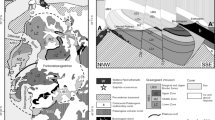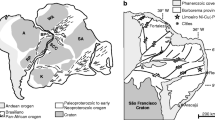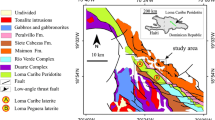Abstract
Platinum-group element (PGE) mineralisation within the Platreef at Overysel is controlled by the presence of base metal sulphides (BMS). The floor rocks at Overysel are Archean basement gneisses, and unlike other localities along the strike of the Platreef where the floor is comprised of Transvaal Supergroup sediments, the intimate PGE–BMS relationship holds strong into the footwall rocks. Decoupling of PGE from BMS is rare and the BMS and platinum-group mineral assemblages in the Platreef and the footwall are almost identical. There is minimal overprinting by hydrothermal fluids; therefore, the mineralisation style present at Overysel may represent the most ‘primary’ style of Platreef mineralisation preserved anywhere along the strike. Chondrite-normalised PGE profiles reveal a progressive fractionation of the PGE with depth into the footwall, with Ir, Ru and Rh dramatically depleted with depth compared to Pt, Pd and Au. This feature is not observed at Sandsloot and Zwartfontein, to the south of Overysel, where the footwall rocks are carbonates. There is evidence from rare earth element abundances and the amount of interstitial quartz towards the base of the Platreef pyroxenites that contamination by a felsic melt derived from partial melting of the gneissic footwall has taken place. Textural evidence in the gneisses suggests that a sulphide liquid percolated down into the footwall through a permeable, inter-granular network that was produced by partial melting around grain boundaries in the gneisses that was induced by the intrusion of the Platreef magma. PGE were originally concentrated within a sulphide liquid in the Platreef magma, and the crystallisation of monosulphide solid solution from the sulphide liquid removed the majority of the IPGE and Rh from it whilst still within the mafic Platreef. Transport of PGE into the gneisses, via downward migration of the residual sulphide liquid, fractionated out the remaining IPGE and Rh in the upper parts of the gneisses leaving a ‘slick’ of disseminated sulphides in the gneiss, with the residual liquid becoming progressively more depleted in these elements relative to Pt, Pd and Au. Highly sulphide-rich zones with massive sulphides formed where ponding of the sulphide liquid occurred due to permeability contrasts in the footwall. This study highlights the fact that there is a fundamental floor rock control on the mechanism of distribution of PGE from the Platreef into the footwall rocks. Where the floor rocks are sediments, fluid activity related to metamorphism, assimilation and later serpentinisation has decoupled PGE from BMS in places, and transport of PGE into the footwall is via hydrothermal fluids. In contrast, where the floor is comprised of anhydrous gneiss, such as at Overysel, there is limited fluid activity and PGE behaviour is controlled by the behaviour of sulphide liquids, producing an intimate PGE–BMS association. Xenoliths and irregular bands of chromitite within the Platreef are described in detail for the first time. These are rich in the IPGE and Rh, and evidence from laurite inclusions indicates they must have crystallised from a PGE-saturated magma. The disturbed and xenolithic nature of the chromitites would suggest they are rip-up clasts, either disturbed by later pulses of Platreef magma in a multi-phase emplacement or transported into the Platreef from a pre-existing source in a deeper staging chamber or conduit.










Similar content being viewed by others
References
Armitage PEB, McDonald I, Edwards SJ, Manby GM (2002) Platinum-group element mineralisation in the Platreef and calc-silicate footwall at Sandsloot, Potgietersrus District, South Africa. Appl Earth Sci (Trans Inst Min Metall B) 111:B36–B45
Barnes S-J, Maier WD (2002a) Platinum-group element distributions in the Rustenburg Layered Suite of the Bushveld Complex, South Africa. In: Cabri LJ (ed) The geology, geochemistry, mineralogy and mineral benificiation of platinum-group elements, special volume. 54. Canadian Institute of Mining, Metallurgy and Petroleum, Montreal, pp 553–580
Barnes S-J, Maier WD (2002b) Platinum-group elements and microstructures of normal Merensky Reef from Impala Platinum Mines, Bushveld Complex. J Petrol 43:103–128
Barnes S-J, Makovicky E, Makovicky M, Rose Hansen J, Karup Moller S (1997) Partition coefficients for Ni, Cu, Pd, Pt, Rh and Ir between monosulphide solid solution and sulphide liquid and the formation of compositionally zoned Ni–Cu sulphide bodies by fractional crystallization of a sulphide liquid. Can J Earth Sci 34:366–374
Barnes S-J, Cox RA, Zientek ML (2005) Cobalt, gold and platinum-group element distribution in compositionally zoned sulphide droplets from the Medvezhy Creek Mine, Noril’sk, Russia. In: Törmänen TO, Alapieti TT (eds) 10th International platinum symposium, Oulu, Finland, 8–11 August 2005, Ext. Abstracts, pp 43–46
Barton Jr JM, Cawthorn RG, White J (1986) The role of contamination in the evolution of the Platreef of the Bushveld Complex. Econ Geol 81:1096–1104
Brenan JM, Andrews D (2001) High-temperature stability of laurite and Ru–Os–Ir alloy and their role in PGE fractionation in mafic magmas. Can Mineral 39:341–360
Buchanan DL, Rouse JE (1984) Role of contamination in the precipitation of sulphides in the Platreef of the Bushveld Complex. In: Buchanan DL, Jones MJ (eds) Sulphide deposits in mafic and ultramafic rocks. IMM, London, pp 141–146
Buchanan DL, Nolan J, Suddaby P, Rouse JE, Viljoen, MJ, Davenport JWJ (1981) The genesis of sulphide mineralisation in a portion of the Potgietersrus Limb of the Bushveld Complex. Econ Geol 76:568–579
Cawthorn RG, Barton Jr JM, Viljoen MJ (1985) Interaction of floor rocks with the Platreef on Overysel, Potgietersrus, Northern Transvaal. Econ Geol 80:988–1006
Fleet ME, Chryssoulis SL, Stone WE, Weisener CG (1993) Partitioning of platinum-group elements and Au in the Fe–Ni–Cu–S system: experiments on the fractional crystallization of sulfide melt. Contrib Mineral Petrol 115:36–44
Friese AEW (2004) Geology and tectono-magmatic evolution of the PPL concession area, Villa Nora-Potgietersrus Limb, Bushveld Complex. Geological Visitor Guide, Potgietersrus Platinums Limited, p 57
Gain SB, Mostert AB (1982) The geological setting of the platinoid and base metal sulphide mineralisation in the Platreef of the Bushveld Complex in Drenthe, north of Potgietersrus. Econ Geol 77:1395–1404
Harris C, Chaumba JB (2001) Crustal contamination and fluid–rock interaction during the formation of the Platreef, Northern Limb of the Bushveld Complex, South Africa. J Petrol 42:1321–1347
Holwell DA, Jordaan A (2006) Three-dimensional mapping of the Platreef at the Zwartfontein South mine: implications for the timing of magmatic events in the northern limb of the Bushveld Complex, South Africa. Appl Earth Science (Trans Inst Min Metall B) 115:40–47
Holwell DA, McDonald I (2005) Platinum-group mineral assemblages within the Platreef, northern Bushveld Complex, South Africa. In: Törmänen TO, Alapieti TT (eds) 10th International platinum symposium, Oulu, Finland, 8–11 August 2005, Ext. abstracts, pp 373–376
Holwell DA, Armitage PEB, McDonald I (2005) Observations on the relationship between the Platreef and its hanging wall. Appl Earth Science (Trans Inst Min Metall B) 114:B199–B207
Holwell DA, McDonald I, Armitage PEB (2006) Platinum-group mineral assemblages in the Platreef at the South Central Pit, Sandsloot Mine, northern Bushveld Complex, South Africa. Mineral Mag 70:83–101
Huber H, Koeberl C, McDonald I, Reimold WU (2001) Geochemistry and petrology of Witwatersrand and Dwyka diamictites from South Africa: search for an extraterrestrial component. Geochim Cosmochim Acta 65:2007–2016
Hulbert LJ, von Gruenewaldt G (1982) Nickel, copper and platinum mineralisation in the Lower Zone of the Bushveld Complex, south of Potgietersrus. Econ Geol 77:1296–1306
Hulbert LJ, von Gruenewaldt G (1986) The structure of the upper and lower chromitite layers on the farms Grasvally and Zoetveld, south of Potgietersrus. In: Anhausser CR, Maske S (eds) Mineral Deposits of Southern Africa, vol. 2. Geological Society of Southern Africa, Johannesburg, pp 1237–1249
Hutchinson D, Kinnaird JA (2005) Complex multi-stage genesis for the Ni–Cu–PGE mineralisation in the southern region of the Platreef, Bushveld Complex, South Africa. Appl Earth Science (Trans Inst Min Metall B) 114:B208–B224
Iljina MJ, Alapieti TT, McElduff BM (1992) Platinum-group element mineralisation in the Suhanko-Konttijärvi intrusion, Finland. Aust J Earth Sci 39:303–313
Kinloch ED (1982) Regional trends in the platinum-group mineralogy of the Critical Zone of the Bushveld Complex, South Africa. Econ Geol 77:1328–1347
Kinnaird JA (2004) What are the questions we need to ask about the Platreef? Platreef Workshop field guide, Mokopane 16–19 July, 2004, Geoscience Africa, University of the Witwatersrand
Kinnaird JA (2005) Geochemical evidence of multiphase emplacement in the southern Platreef. Appl Earth Science (Trans Inst Min Metall B) 114:B225–B242
Kinnaird JA, McDonald I (2005) An introduction to the mineralisation in the northern limb of the Bushveld Complex. Appl Earth Science (Trans Inst Min Metall B) 114:B194–B198
Kinnaird JA, Hutchinson D, Schürmann L, Nex P, de Lange R (2005) Petrology and mineralisation of the southern Platreef: northern limb of the Bushveld Complex, South Africa. Miner Depos 40:576–597
Kruger FJ (2005) Thoughts on the Platreef—a critical zone or main zone phenomenon? 2nd Platreef Workshop, Abstract Volume, Geological Society of South Africa, Johannesburg
Lee CA (1996) A review of mineralisation in the Bushveld Complex and some other layered mafic intrusions. In: Cawthorn RG (ed) Layered intrusions. Elsevier, pp 103–146
Li C, Naldrett AJ (1993) Platinum-group minerals from the Deep Copper Zone of the Strathcona deposit, Sudbury, Ontario. Can Mineral 31:31–44
Manyeruke TD, Maier WD, Barnes S-J (2005) Major and trace element geochemistry of the Platreef on the farm Townlands, northern Bushveld Complex. S Afr J Geol 108:381–396
McDonald I, Holwell DA, Armitage PEB (2005) Geochemistry and mineralogy of the Platreef and “Critical Zone” cumulates of the Northern limb of the Bushveld Complex, South Africa: implications for Bushveld stratigraphy and the development of PGE mineralisation. Miner Depos 40:526–549
Mungall JE, Su S (2005) Interfacial tension between magmatic sulfide and silicate liquids: constraints on kinetics of sulfide liquation and sulfide migration through silicate rocks. Earth Planet Sci Lett 234:135–149
Mungall JE, Andrews DRA, Cabri LJ, Sylvester PJ, Tubrett M (2005) Partitioning of Cu, Ni, Au, and platinum-group elements between monosulfide solid solution and sulfide melt under oxygen and sulfur fugacities. Geochim Cosmochim Acta 69:4349–4360
Naldrett AJ, Innes DG, Sowa J, Gorton MP (1982) Compositional variations within and between five Sudbury ore deposits. Econ Geol 77:1519–1534
Nex PAM (2005) The structural setting of mineralisation on Tweefontein Hill, northern limb of the Bushveld Complex, South Africa. Appl Earth Science (Trans Inst Min Metall B) 114:B243–B291
Sharman-Harris E, Kinnaird JA, Harris C, Horstmann UE, Wing B (2005) A new look at sulphide mineralisation of the northern limb, Bushveld Complex: a stable isotope study. Appl Earth Science (Trans Inst Min Metall B) 114:252–263
Taylor SR, McLennan SM (1985) The Continental Crust: its composition and evolution. Blackwell Scientific, UK, pp 312
Tredoux M, Lindsay NM, Davies G, McDonald I (1995) The fractionation of platinum-group elements in magmatic systems, with the suggestion of a novel causal mechanism. S Afr J Geol 98:157–167
van der Merwe MJ (1976) The Layered Sequence of the Potgietersrus Limb of the Bushveld Complex. Econ Geol 71:1337–1351
Wagner PA (1929) The platinum deposits and mines of South Africa. Oliver & Boyd, Edinburgh, p 326
White JA (1994) The Potgietersrus prospect—geology and exploration history. XVth CMMI Congress, Johannesburg. SAIMM 3:173–181
Wood SA (2002) The aqueous geochemistry of the platinum-group elements with applications to ore deposits. In: Cabri LJ (ed) The geology, geochemistry, mineralogy and mineral benificiation of platinum-group elements, special vol. 54. Canadian Institute of Mining, Metallurgy and Petroleum, Montreal, pp 211–249
Acknowledgements
The authors would like to thank the management of Anglo Platinum for giving permission to publish this work and for allowing access to the Sandsloot and Zwartfontein South mines and core from Overysel. David Holwell’s Ph.D. research is funded by the Natural Environment Research Council and supported by Anglo Platinum through Industrial CASE project (NER/S/C/2003/11952). Whole-rock sulphur analysis was performed at the Camborne School of Mines, UK, and funded by the Society of Economic Geologists’ Hugh Exton McKinstry Fund. Professor Tony Harris is acknowledged for his insightful discussions on the metamorphic petrology of the footwall and Jeff White, Jim Mungall, and Tony Naldrett are also thanked for their comments. Constructive reviews by Steve Prevec and an anonymous referee helped improve the quality of the manuscript. Thanks also to Cheryl Tippins for her assistance drafting some of the figures and to Jay Cockayne for her support and for proof reading the manuscript.
Author information
Authors and Affiliations
Corresponding author
Additional information
Editorial handling: P. Lightfoot
Rights and permissions
About this article
Cite this article
Holwell, D.A., McDonald, I. Petrology, geochemistry and the mechanisms determining the distribution of platinum-group element and base metal sulphide mineralisation in the Platreef at Overysel, northern Bushveld Complex, South Africa. Miner Deposita 41, 575–598 (2006). https://doi.org/10.1007/s00126-006-0083-5
Received:
Accepted:
Published:
Issue Date:
DOI: https://doi.org/10.1007/s00126-006-0083-5




